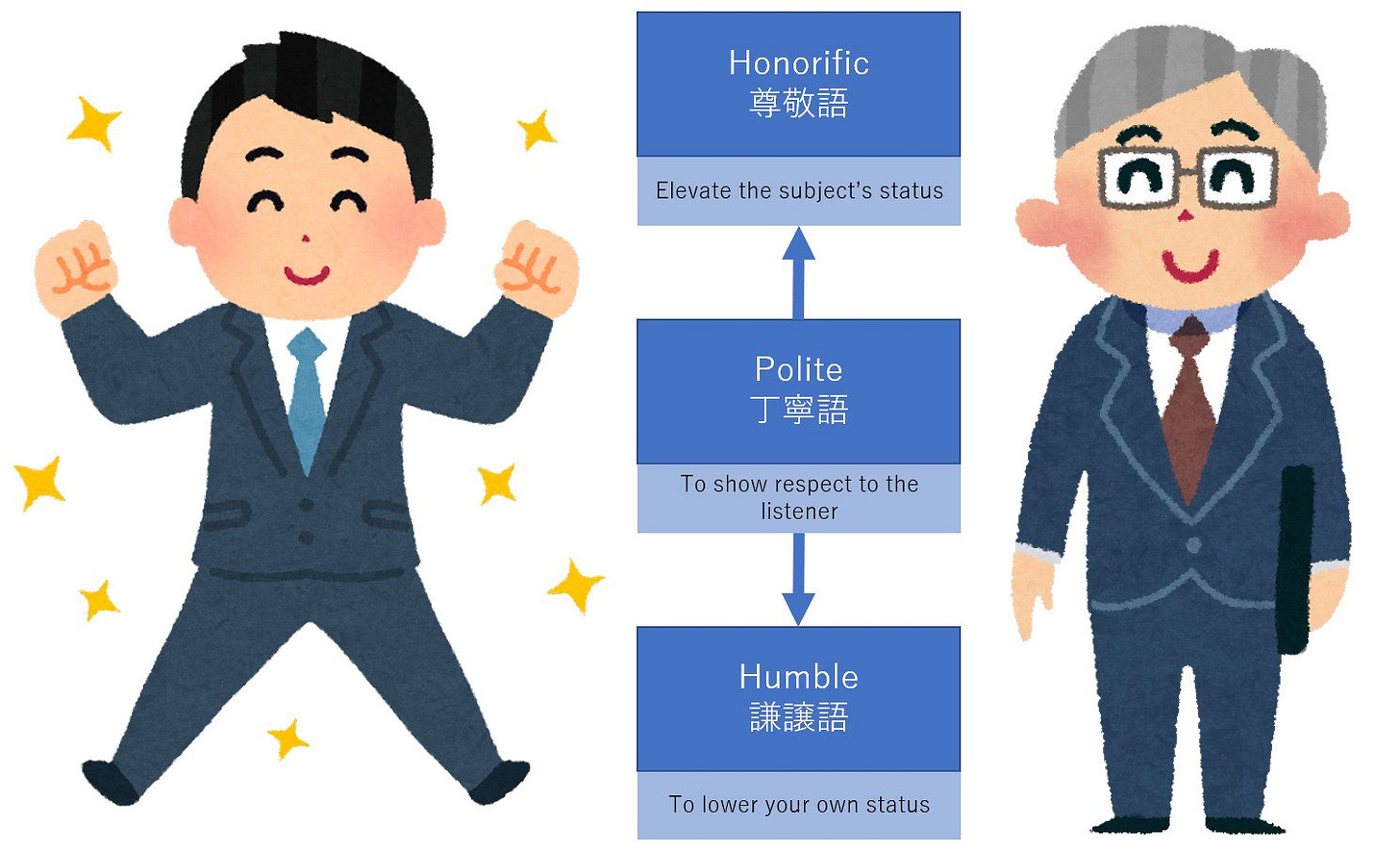Navigating Honorifics as a Foreigner
Japan is famous for its honorific system, known as "Keigo," which is used as part of Japanese hierarchies. But how does this interact with the outsider status of a foreigner living in Japan?
As an exchange student in Nara, I attended an international communication and critical thinking course. Although it was a class for English majors, the professor also encouraged international students to attend to create a more diverse discourse during in-class discussions.
One day, I remember the discussion around communication styles arose as the professor’s lecture compared how polite speech worked in English versus Japanese. During the discussion, one of the classmates explained how she felt uncomfortable because sometimes, when she spoke to foreign peers in Japanese, they would use casual speech and refer to her by her first name, even the first time they met.
After that lecture, I notice differences between American and Japanese communication more often. In America, switching to informal communication styles establishes equal footing within the conversation to “break the ice” and get to know one another.
However, in Japanese, communication seemed to have a different fundamental goal. Instead of trying to establish equality, honorifics (or Keigo/敬語) function as a way to show respect for the other person. Creating a linguistic hierarchy became a tool to demonstrate things like gratitude and acknowledgment of another person’s position. For example, using honorifics towards one’s senpai (or upperclassman) was partly a way to acknowledge and express gratitude as they took on the mentor role.
As I developed deeper fluency in Japanese, this structure in the language became more apparent, but I noticed something distinctly different between me and my Japanese peers. I was a foreigner, I didn’t traditionally exist within Japanese social hierarchies.
How Linguistic Structures Reflect Social Structures
In Structure, Culture, and Languages, Johan Galtung examines how linguistic structures reflect and reinforce social structures, particularly focusing on how these structures shape communication and hierarchy.
Galtung’s theoretical framework emphasizes that language is not only a tool for communication but also a vehicle that reinforces societal hierarchies and cultural norms. He argues that a language's syntax, vocabulary, and use of honorifics are directly linked to the underlying social order and relationships within a society.
One of his key theoretical points is that languages with more rigid hierarchical structures—like Japanese—tend to reflect and perpetuate the culture’s social hierarchies. In particular, Japan’s system of honorifics enforces a clear distinction between social ranks.
This system requires speakers to constantly adjust their language based on the relative status of their conversation partners. As a result, communication in Japanese reflects social position, where the language structure forces individuals to continuously signal respect, submission, or authority depending on their role in social interaction.
Galtung provides a specific example of how Japanese linguistic structures embody hierarchy through honorifics. He discusses how the use of different verb forms and honorific markers in Japanese elevates the status of the listener or diminishes the speaker’s own status, depending on the situation.

This contrasts with languages like Chinese, where hierarchical distinctions are less embedded in the grammar, and Indo-European languages, where individualism is more prominent in communication patterns.
Thus, Galtung concludes that in Japanese, the structure of the language both reflects and reinforces societal hierarchies, making communication a tool for maintaining social order.
Honorifics as an Indicator of Social Class
Similar to Galtung, Masao Watanabe’s work also looks at linguistic structure as a reflection of social structure in Japan. Specifically, he looks at class and language, suggesting that honorifics are a clear indicator of social class and power in Japanese society, and mastering these linguistic elements can be seen as a way to demonstrate cultural competence. One function of the system of honorifics requires speakers to navigate power dynamics.
A clear expression of societal rank, where language is used to recognize and reinforce the relative social positions of the speakers involved, is a form of "class honorifics" (階級敬語), which includes forms like absolute honorifics and status honorifics. These honorifics function based on a speaker's awareness of the power dynamics, such as seniority, social status, or institutional rank.
Even today, honorifics remain significant in maintaining social hierarchies, particularly in professional and institutional settings. For instance, using appropriate honorifics in corporate environments is crucial for preserving internal hierarchy and reinforcing the company's structure. It acts as a way of acknowledging the position and knowledge of a superior about one’s position, creating clear boundaries in such relationships.
However, learners who struggle with honorifics may be perceived as less competent or outsiders within the social structure. This reflects the broader societal expectations surrounding language use in Japan.
In past research, when Japanese native speakers perceived Japanese used by foreign learners, they tended to adjust their communication, taking into consideration the learner’s language proficiency. However, despite these adjustments, there were still cases where misunderstandings arose, especially when learners could not respond in the expected way due to cultural or linguistic gaps.
This caused native speakers to feel unease when foreign learners failed to align with the subtleties of Japanese conversational norms, such as using indirect forms of agreement. Even with the expectation that the foreigner’s Japanese use differed from a native speaker’s, social expectations are still embedded into the linguistic proficiency of non-native speakers.
Being a Foreigner in a World of Keigo
As foreigners, it is normal for us to get lost when navigating social relationships in Japan. I remember once asking a close friend, “How do I know when I switch between polite and casual speech?”
There was a long pause as he thought about it, and then he said, “I’m not sure. It depends on the person; sometimes they are casual type personalities, but other times they are more formal type personalities.”
His words rang true throughout my experience. It felt as if everyone I met applied the rules differently regarding honorifics. This isn’t an issue unique to learners of Japanese, as many Japanese natives also struggle with the ambiguity of navigating social hierarchies, but being a foreigner added a new layer of complexity.
Some Japanese individuals I interacted with not only expected but insisted on using English norms of hierarchy instead of Japanese. Others with little to no exposure to English felt the opposite. I’ve had Japanese speakers drop honorifics when referring to me but maintain them when referring to other Japanese peers, creating a difference in the linguistic structure that is hard to account for in traditional social patterns.
Research shows that many foreign residents perceive the Japanese language as complex due to the cultural knowledge required to use it appropriately. As discussed in a past article, Japanese contains a lot of ambiguity that often requires cultural contexts to interpret, which is true for honorifics as well.
When specifically mastering the honorifics in Japanese, it often leads to anxiety as learners recognize the social expectations surrounding the correct use of politeness levels. Yet, even despite their efforts to learn, mastery still does not necessarily guarantee integration or belonging into Japanese society.
Many learners exhibit high motivation in Japanese studies because they want to feel more connected to Japanese culture and society. Language proficiency becomes a symbol of their effort to integrate, but the perceived gap between their language skills and the cultural acceptance from native speakers can create frustration and hinder motivation.
Yet, despite the challenges, understanding and using Japanese enhances a foreign resident’s sense of identity within the Japanese-speaking community. This creates a dual nature of the Japanese language as both a tool for deeper cultural understanding and a source of difficulty due to its inherent connection to societal structures.
The constant switch within social norms based on the perception of one’s foreignness adds a new layer of complexity when navigating social hierarchy and interactions in Japanese.
Do you wish to learn more about Keigo basics? Feel free to reference my past article, “Japan’s Honorific Culture: Why do I have to be so polite all the time in Japan?”
For advanced Japanese learners, 日本語の森’s book 「教えて!ゆか先生 気持ちが伝わる日本語敬語」 also provides a great lesson on how to use Keigo to express yourself in Japanese.





